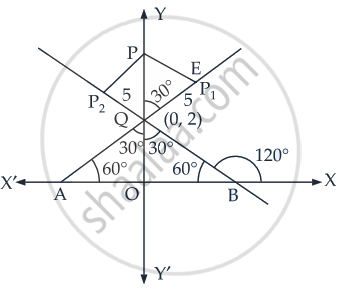Advertisements
Advertisements
Question
P1, P2 are points on either of the two lines `- sqrt(3) |x|` = 2 at a distance of 5 units from their point of intersection. Find the coordinates of the foot of perpendiculars drawn from P1, P2 on the bisector of the angle between the given lines.
Solution
Given lines are `- sqrt(3) |x|` = 2
⇒ `y - sqrt(3)x` = 2, if x ≥ 0 .....(i)
And `y + sqrt(3)x` = 2, if x < 0 ......(ii)
Slope of equation (i) is tan θ = `sqrt(3)`
∴ θ = 60°
Slope of equation (ii) is tan q `- sqrt(3)`
∴ θ = 120°
Solving equation (i) and equation (ii) we get
`y - sqrt(3) = 2`
`y + sqrt(3)x = 2`
2y = 4
⇒ y = 2
Putting the value of y is eq. (i) we get
x = 0
∴ Point of intersection of line (i) and (ii) is Q(0, 2)
∴ QO = 2
In ΔPEQ,
cos 30° = `"PQ"/"QE"`
`sqrt(3)/2 = "PQ"/5`
∴ PQ = `(5sqrt(3))/2`
∴ OP = OQ + PQ
= `2 + (5sqrt(3))/2`
Hence, the coordinates of the foot of perpendicular = `(0, 2 + (5sqrt(3))/02)`.
APPEARS IN
RELATED QUESTIONS
Find the angle between the x-axis and the line joining the points (3, –1) and (4, –2).
The slope of a line is double of the slope of another line. If tangent of the angle between them is `1/3`, find the slopes of the lines.
Find the slope of the lines which make the following angle with the positive direction of x-axis: \[\frac{\pi}{3}\]
State whether the two lines in each of the following is parallel, perpendicular or neither.
Through (6, 3) and (1, 1); through (−2, 5) and (2, −5)
State whether the two lines in each of the following is parallel, perpendicular or neither.
Through (3, 15) and (16, 6); through (−5, 3) and (8, 2).
Using the method of slope, show that the following points are collinear A (4, 8), B (5, 12), C (9, 28).
What can be said regarding a line if its slope is positive ?
Consider the following population and year graph:
Find the slope of the line AB and using it, find what will be the population in the year 2010.

Find the angle between X-axis and the line joining the points (3, −1) and (4, −2).
Find the equations of the straight lines which cut off an intercept 5 from the y-axis and are equally inclined to the axes.
The line through (h, 3) and (4, 1) intersects the line 7x − 9y − 19 = 0 at right angle. Find the value of h.
Find the angles between the following pair of straight lines:
3x + 4y − 7 = 0 and 4x − 3y + 5 = 0
Find the angles between the following pair of straight lines:
x − 4y = 3 and 6x − y = 11
Prove that the straight lines (a + b) x + (a − b ) y = 2ab, (a − b) x + (a + b) y = 2ab and x + y = 0 form an isosceles triangle whose vertical angle is 2 tan−1 \[\left( \frac{a}{b} \right)\].
If two opposite vertices of a square are (1, 2) and (5, 8), find the coordinates of its other two vertices and the equations of its sides.
Write the coordinates of the image of the point (3, 8) in the line x + 3y − 7 = 0.
The acute angle between the medians drawn from the acute angles of a right angled isosceles triangle is
Find k, if the slope of one of the lines given by kx2 + 8xy + y2 = 0 exceeds the slope of the other by 6.
If m1 and m2 are slopes of lines represented by 6x2 - 5xy + y2 = 0, then (m1)3 + (m2)3 = ?
Find the equation of the straight line passing through (1, 2) and perpendicular to the line x + y + 7 = 0.
If the line joining two points A(2, 0) and B(3, 1) is rotated about A in anticlock wise direction through an angle of 15°. Find the equation of the line in new position.
The reflection of the point (4, – 13) about the line 5x + y + 6 = 0 is ______.
Find the equation of a straight line on which length of perpendicular from the origin is four units and the line makes an angle of 120° with the positive direction of x-axis.
If the equation of the base of an equilateral triangle is x + y = 2 and the vertex is (2, – 1), then find the length of the side of the triangle.
If p is the length of perpendicular from the origin on the line `x/a + y/b` = 1 and a2, p2, b2 are in A.P, then show that a4 + b4 = 0.
The equation of the straight line passing through the point (3, 2) and perpendicular to the line y = x is ______.
The point (4, 1) undergoes the following two successive transformations:
(i) Reflection about the line y = x
(ii) Translation through a distance 2 units along the positive x-axis Then the final coordinates of the point are ______.
One vertex of the equilateral triangle with centroid at the origin and one side as x + y – 2 = 0 is ______.
The vertex of an equilateral triangle is (2, 3) and the equation of the opposite side is x + y = 2. Then the other two sides are y – 3 = `(2 +- sqrt(3)) (x - 2)`.
